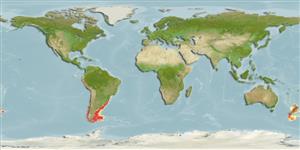Common names from other countries
Environment: milieu / climate zone / depth range / distribution range
Ekologi
Batidemersal. Tropical; 0°N - 90°S, 180°W - 180°E
Southeast Pacific and Southwest Atlantic: South America. Tropical to temperate.
Length at first maturity / Size / Weight / umur
Maturity: Lm ? range ? - ? cm Max length : 260 cm TL jantan/; (Ref. 1394); 220 cm TL (female); Berat maksimum terpublikasi: 350.0 kg (Ref. 1394); Berat maksimum terpublikasi: 350.0 kg
Found over the continental shelf and slope. Occurs in deep waters, and also venture into freshwaters in rivers and around glaciers. Feeds on many species of benthic and pelagic fishes, and invertebrates (i.e. lobster, krill, squid, octopus, and jellyfish), and occasionally penguins and young South American seals) (Ref. 1394). Preyed upon by a sevengill shark (Ref. 8910). Found over the continental shelf and slope. Occurs in deep waters, and also venture into freshwaters in rivers and around glaciers. Feeds on many species of benthic and pelagic fishes, and invertebrates (i.e. lobster, krill, squid, octopus, and jellyfish), and occasionally penguins and young South American seals) (Ref. 1394).
rujukan utama
Acuan | Koordinator | mitra
Jefferson, T.A., S. Leatherwood and M.A. Webber. 1993. (Ref. 1394)
Status IUCN Red List (Ref. 130435)
status CITES (Ref. 108899)
Not Evaluated
penggunaan manusia
Perikanan: komersial
FAO - Perikanan: landings, profail spesis | FishSource | Sea Around Us
Alat, peralatan
Sumber internet
Estimates based on models
Preferred temperature
(Ref.
115969): 6.3 - 15.6, mean 9.9 (based on 922 cells).
Daya lenting
Tinggi, Waktu penggandaan populasi minimum kurang dari 15 bulan (K=0.31-0.31).
keancaman
Moderate to high vulnerability (51 of 100).
kategori harga
Unknown.
